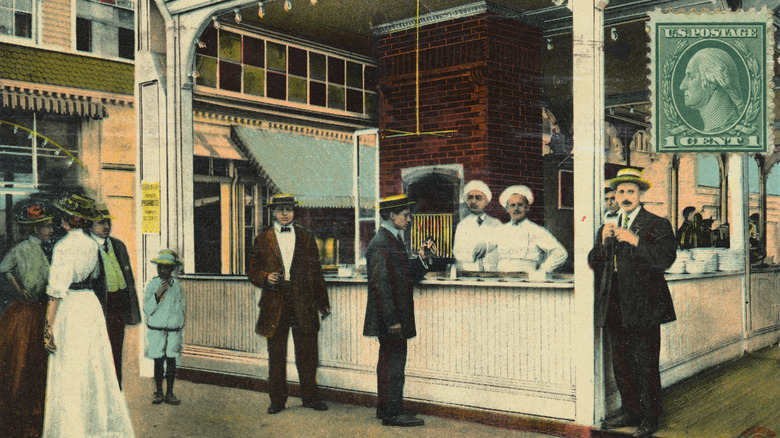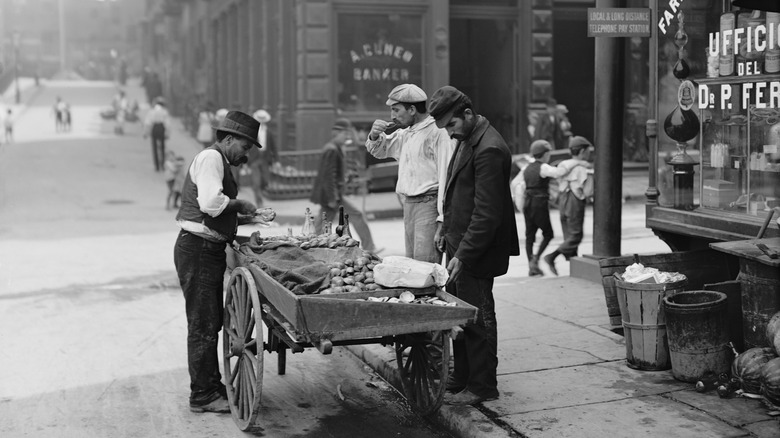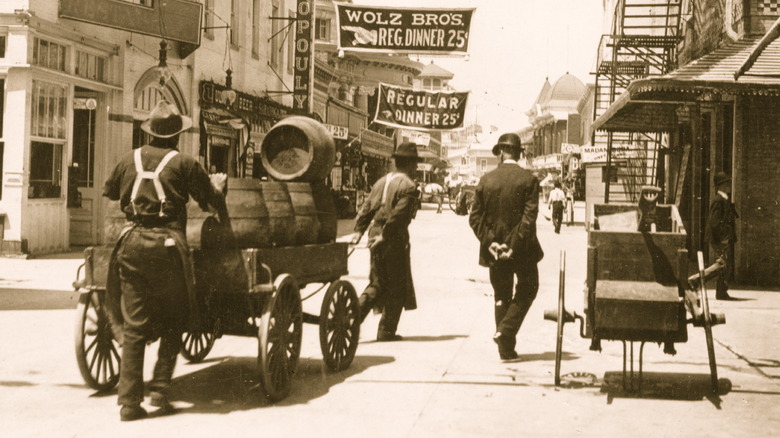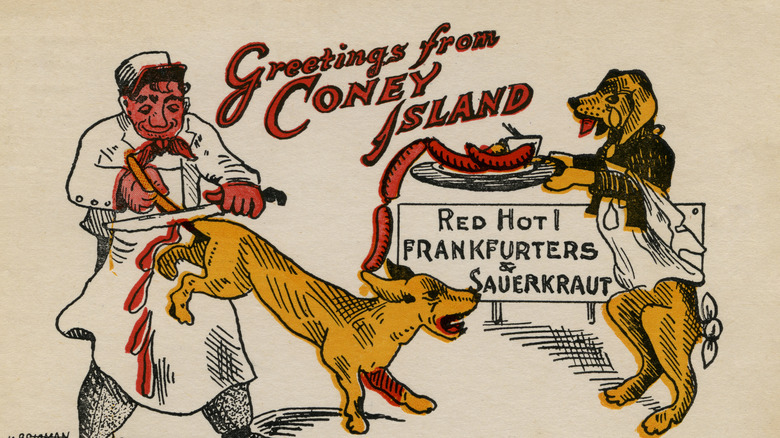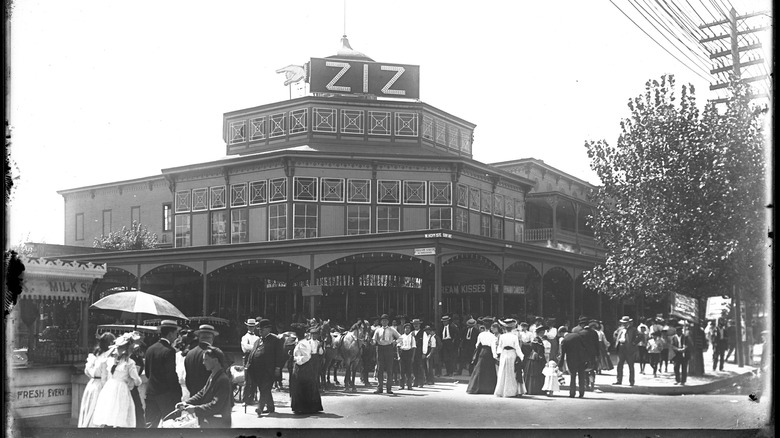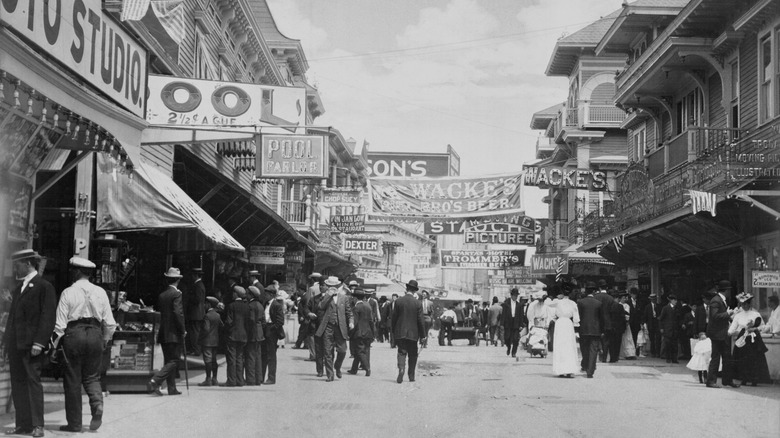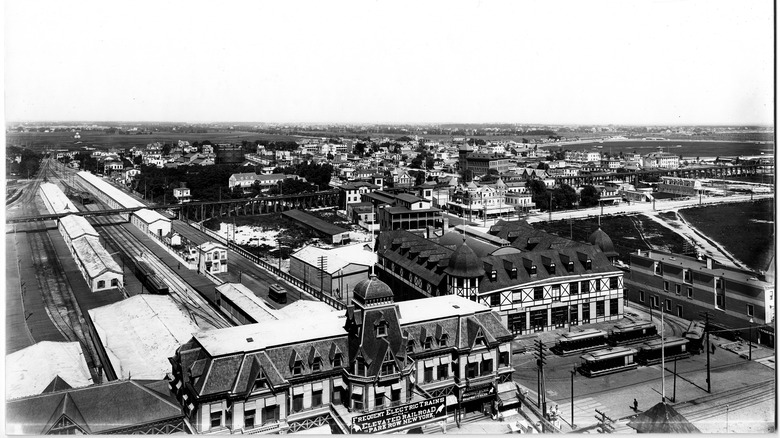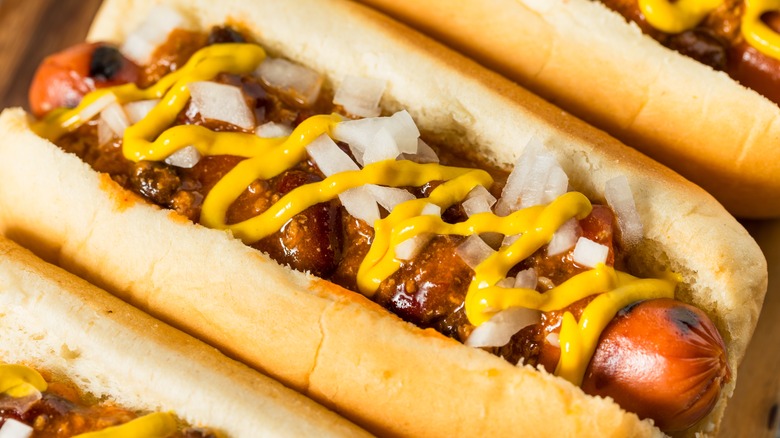What It Was Like To Eat At The First Hot Dog Stand
Before the irresistible combination of a sausage in a bun conquered the US and the world, it had to be invented. Although today there are many different hot dog styles, Coney Island is where the story of hot dogs began. It's in this seaside neighborhood of New York City that German immigrant Charles Feltman started selling the beloved comfort food in 1867. He was inspired by frankfurter sausages that were popular in his home country and decided to adapt the recipe by adding an elongated bun.
And the people loved the new street food treat. Feltman's restaurant empire grew to become one of the biggest in the world. By the 1920s, he sold 40,000 hot dogs a day. It was a true American dream scenario: a tale of hard work, seized opportunities, and enormous success. Feltman's hot dog business operated for more than 100 years, finally closing its doors in 1954. While there were attempts to revive the brand, the original Coney Island location was torn down so the first hot dog stand lives only in retro pictures. Let's revive the colorful history of one of the most recognized snacks in the world.
Charles Feltman invented the hot dog as we know it in 1867
If you came to Coney Island in 1867, you could have encountered Charles Feltman and his iconic pushcart with hot dogs. When Feltman's family emigrated to the United States from Germany he brought with him his love of frankfurters.
Feltman opened his first business, a modest Brooklyn bakery, in 1865 and moved around the seaside amusement neighborhood selling cold foods, such as pies and clams from his pushcart. He soon saw the potential to change the status quo, and decided to serve something hot from his pushcart to the Coney Island clientele. He wanted to offer something customers could take with them to the beach or eat while strolling the boardwalk — that's how the hot dog was born. Instead of serving the sausage with a side of bread, Feltman put it inside the elongated bun, omitting the need for cutlery and plates, and making it perfect for eating on the go.
Feltman customized his pie cart to sell hot dogs
The recipe for a new invention was one part of the success, but a pushcart was equally important to provide New Yorkers with warm food. Feltman was an innovator at heart so he adapted the traditional pie cart to sell hot dogs. Pushcarts were as symbolic of New York City in the 19th century as the yellow taxis in the 21st. The city regulated outdoor peddling and you had to obtain a special license (costing a few dollars) to start selling on the street.
But the traditional pushcart didn't work for the new hot food, so Feltman had to build his own. He added a brazier to the structure and modified it with a separate metallic space for heated buns. Now everything was ready for a hot dog revolution. This was a perfect know-how for serving takeaway food in rapidly changing Coney Island.
Hot dogs were priced at a nickel
When Feltman started selling his hot dogs he charged a nickel. The average monthly wage in New York in the middle of the 19th century was $11.50 so that was a great deal for the residents. The Civil War just ended, the country was trying to find a new economic direction, and the hot dog was a perfect affordable food that made everyone happy.
The summer of 1867 was pivotal for Charles Feltman's hot dog pushcart enterprise and he sold more than 4,000 sausage buns. As the popularity of the new hot food grew, so did the popularity of Coney Island. Feltman brought the right snack at the right location and at the right time. The pushcart business was so successful that he was able to buy the land plot on West 10th Street in 1871. A premier beachside location became the basis for a new restaurant empire that determined New York's leisure for both the 19th and 20th centuries.
The hot dog was initially called Coney Island Red Hot
The name "hot dog" wasn't around when Feltman started putting the sausages in the bun. The snack was called "Coney Island Red Hots" in 1867 probably because of the red color of the sausages. The origins of the word "hot dog" are disputed and there are several theories of who and when exactly coined the term.
The canine part of the name comes from the dachshund breed that originated in Germany in the 1690s. According to the National Hot Dog and Sausage Council, the name has a surprising baseball connection too. The hot dogs were already a fixture at baseball games at the beginning of the 20th century where they were sold by vendors how called out, "hot dachshund sausages!" Cue Ted Doogan, a New York Journal sports cartoonist who became famous for introducing new slang words. The story goes that he didn't know how to write "dachshund" and used a "hot dog" instead. Another popular hot dog fact states that the name was first used in the edition of Paterson (New Jersey) Daily Press where a traveling vendor was named "Hot Dog Morris."
Feltman's hot dog cart business grew into a restaurant empire
Once Charles Feltman felt the initial hot dog success, he didn't stop growing his brand. The story of his business is one of the best examples of the American dream. After buying a seaside plot, in 1873 Feltman opened a culinary institution that very much defined Coney Island at the end of the 19th century.
The restaurant was called Ocean Pavilion and encompassed multiple ventures that took over a block of beachside promenade. The trademark hot dogs were still sold (prepared on seven grills at the restaurant), but the price went up from a nickel to 10 cents; the number sold counted in the millions.
Feltman died in 1910 as one of the city's well-known tycoons. The New York Times obituary called him a "Coney Island pioneer who turned sandy wastes into pleasure ground."
In the '20s, Feltman's restaurant was considered the largest in the world
By the beginning of the 20th century, Feltman had built a full-fledged entertainment empire in Coney Island that included nine restaurants, a hotel, a bathhouse, an Alpine village, and even an outdoor movie theater. In the 20s, it was estimated that Feltman's Ocean Pavilion had 5 million customers per year on average, sold up to 40,000 hot dogs a day, and had became one of the largest restaurants in the world. Not bad for a former street peddler with a pushcart.
The business plan that Feltman set out in the 1880s proved to be successful. He saw the big potential in Coney Island and was quick to lead the process of the neighborhood's fast development. Feltman's Ocean Pavilion was a year-round establishment with a diversified portfolio.
Subsequently, Feltman added the ballroom that featured 400 gas lights and an elegant interior, the carousel, and the popular German-inspired beer garden. The latter was an especially treasured addition for the founder as it reminded him of his childhood. The so-called Deutscher Garten had a replica of the Bavarian inn and beer hall as well as featured hundreds of evergreen trees.
Culver Line's schedule was changed because of Feltman's hot dog popularity
Before Coney Island became an iconic amusement powerhouse, the area was an unremarkable and gloomy chunk of land along the Atlantic Ocean. It was the railroad that played a large role in this neighborhood's transformation. In the second half of the 19th century, railroads were privately owned and competed with each other to open a line to West Brighton (as Coney Island was known at the time).
One of the lines was built by Andrew Culver, who was the head of Prospect Park and Coney Island Railroad. It opened in 1875 and ran from Green-Wood Cemetery to Culver Depot in Coney Island. Originally, it was supposed to run only until 7:15 p.m. on weekdays, which didn't coincide with Feltman's plan to get New Yorkers to dine in his establishment. So he met with Culver and convinced him to change the schedule of the line, prolonging the departure time from Coney Island to 9:30 p.m. This proved to be a wise lobbying decision on Feltman's part.
The original Feltman's restaurant closed in 1954 and was revived in 2017
After the WWII, Feltman's restaurant empire started to show cracks. Firstly, in 1946, the elderly sons of Charles Feltman who were at the helm of the hot dog-selling institution decided to sell the business. Feltman's finally closed in 1954, leaving a bright mark in Coney Island's colorful history.
But Feltman's history didn't end completely. Brothers Michael and Joe Quinn reopened the hot dog pioneering institution in 2017 in a small kiosk. A Coney Island history aficionado and a veteran, they purchased the rights to Feltman's name and used the original hot dog recipe that was passed to them by their grandfather. But the operation of the revived Feltman's didn't last long; in 2019 the stand was closed again due to the restraints posed by the coronavirus pandemic. Now you can only purchase Feltman's hot dogs in select grocery stores around the country.
Feltman's broke the world record for the longest hot dog in 2019
Feltman's hot dogs continue to impress and break records in the 21st century. The brand's current owner, Michael Quinn, decided to make something special to bring attention to his company and help a good cause. In 2019, the brand introduced a 5-foot-long and 1-foot-wide hot dog officially setting a new world record. In true New York City showman fashion, the ceremony of inaugurating the gigantic hot dog featured smoking the 120-pound beef sausage in the special "jacuzzi" grill bathtub. Every hot dog needs a bun, and Brooklyn-based Michael's Restaurant and Bakery (another Quinn-owned company) provided one that was 31 pounds.
The finished hot dog weighed 66 pounds and was exhibited in the Financial District. This wasn't just a giant food showcase, the whole record-breaking was done for a veteran mental health-focused non-profit called Headstrong. The gargantuan Coney Island Red Hot from Feltman's was then sliced and sold in exchange for donations.
